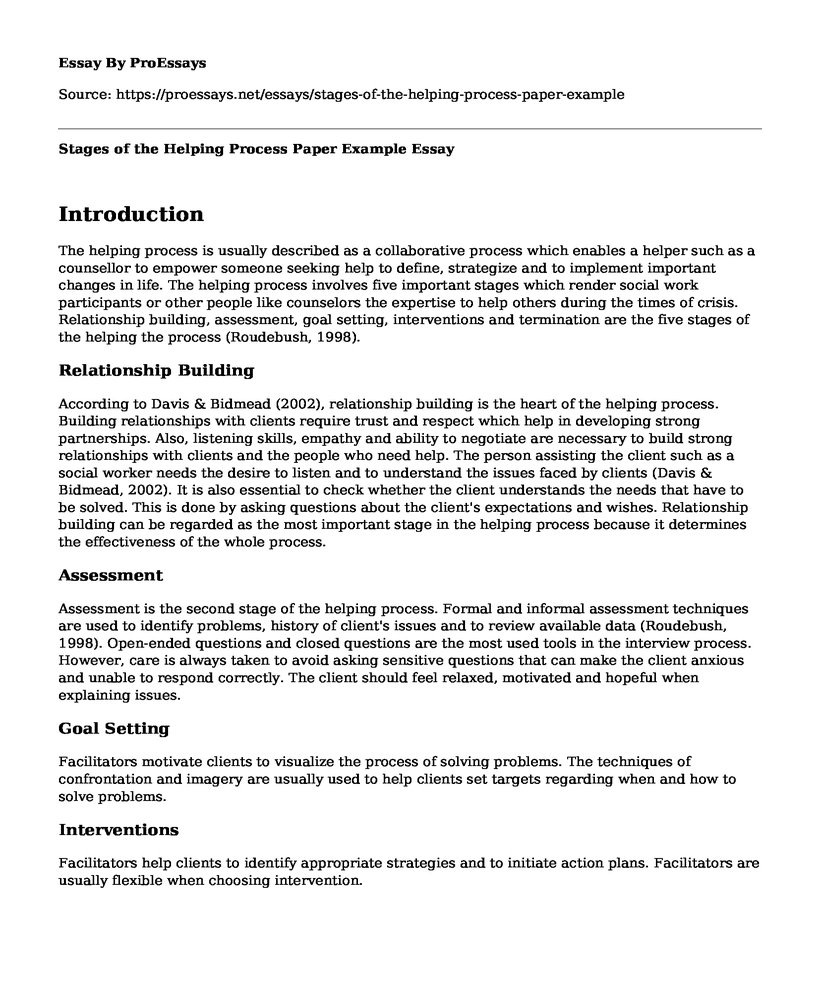Introduction
The helping process is usually described as a collaborative process which enables a helper such as a counsellor to empower someone seeking help to define, strategize and to implement important changes in life. The helping process involves five important stages which render social work participants or other people like counselors the expertise to help others during the times of crisis. Relationship building, assessment, goal setting, interventions and termination are the five stages of the helping the process (Roudebush, 1998).
Relationship Building
According to Davis & Bidmead (2002), relationship building is the heart of the helping process. Building relationships with clients require trust and respect which help in developing strong partnerships. Also, listening skills, empathy and ability to negotiate are necessary to build strong relationships with clients and the people who need help. The person assisting the client such as a social worker needs the desire to listen and to understand the issues faced by clients (Davis & Bidmead, 2002). It is also essential to check whether the client understands the needs that have to be solved. This is done by asking questions about the client's expectations and wishes. Relationship building can be regarded as the most important stage in the helping process because it determines the effectiveness of the whole process.
Assessment
Assessment is the second stage of the helping process. Formal and informal assessment techniques are used to identify problems, history of client's issues and to review available data (Roudebush, 1998). Open-ended questions and closed questions are the most used tools in the interview process. However, care is always taken to avoid asking sensitive questions that can make the client anxious and unable to respond correctly. The client should feel relaxed, motivated and hopeful when explaining issues.
Goal Setting
Facilitators motivate clients to visualize the process of solving problems. The techniques of confrontation and imagery are usually used to help clients set targets regarding when and how to solve problems.
Interventions
Facilitators help clients to identify appropriate strategies and to initiate action plans. Facilitators are usually flexible when choosing intervention.
Termination and Follow-up
This is the final stage of the helping process. The facilitator and clients agree when to end the helping process, usually after the problem is successfully solved. However, the client provides the client with support and guidance before the relationship is terminated (Helping Process, n.d).
References
Davis, H., Day, C., and Bidmead, C. (2002). Working in Partnership with Parents. Pearson Education.
Helping Process. (n.d.). Retrieved October on 25, 2018, from https://www.webpages.uidaho.edu/psyc478www/topics/helping_process.htm
Roudebush, S. (1998). The rationale for Using Basic Helping Skills. Retrieved on 25, 2018, from http://susanroudebush.home.mindspring.com/courses/lessons/lesson8.html
Cite this page
Stages of the Helping Process Paper Example. (2022, Sep 20). Retrieved from https://proessays.net/essays/stages-of-the-helping-process-paper-example
If you are the original author of this essay and no longer wish to have it published on the ProEssays website, please click below to request its removal:
- Essay Sample on Cardiovascular Disease
- Self-Care: Mindful Running Essay Example
- Questions and Answers on Mobility - Paper Example
- Paper Example on EBP in Mental and Behavioral Health Facility
- Essay Sample on Strategies of Meditation and Self-Reflection
- Group Singing: Benefits to Mental & Physical Health - Essay Sample
- Psychological Risks and Resilience in Children and Adolescents - Essay Sample







